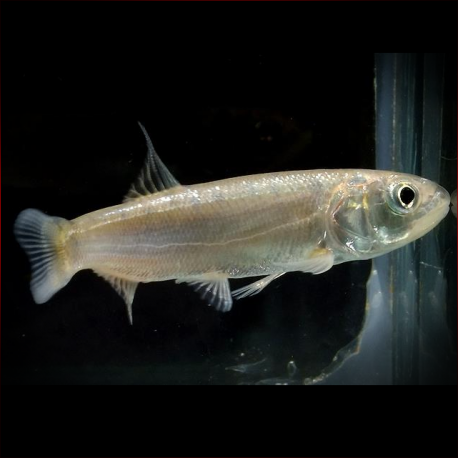More info
Datasheet
| Minimum Tank Size | 540 litres / 142.65 US gallons |
| Maximum Size | 13.0cm / 5.12inches |
| Temperature | 18°C / 64.40°F - 26°C / 78.80°F |
| Hardness | 2.02dgH / 36ppm - 12.05dgH / 215ppm |
| pH | 6.0-7.5 |
General Description
The Barilius shacra, also known as Opsarius cirratus, is a species within the Cyprinidae family. It is characterized by distinct features such as the presence of maxillary and rostral barbels, poorly-developed tubercles on the head and body, and a specific range of lateral line scales and vertical bars. This fish can reach a maximum size of 13.0cm and is native to rivers in Nepal, northern India, and Bangladesh.
Aquarium Setup
Creating an environment resembling a flowing stream or river is ideal for the Barilius shacra. The tank should contain a substrate of rocks, sand, fine gravel, and water-worn boulders. Incorporating driftwood, roots, and branches is beneficial, along with hardy aquatic plants like Microsorum, Bolbitis, or Anubias species. To maintain the fish's well-being, clean water with high oxygen levels and moderate water movement is essential. Regular water changes and a secure cover to prevent jumping are recommended.
Behaviour
This species is gregarious but forms shoals with a distinct pecking order. Maintaining them in groups of five or more individuals is crucial to prevent bullying or aggression. Barilius shacra is a fast swimmer and vigorous feeder, making it unsuitable for tanks with slower or smaller species. Compatible tankmates include similarly-sized, robust cyprinids like Dawkinsia, Devario, and Rasbora species, along with certain bottom-dwelling fish such as Garra, Crossocheilus, Botia, and Schistura species.
Feeding and Diet
In their natural habitat, Barilius shacra primarily feed on surface insects and small fishes. In the aquarium, they accept high-quality dried foods but should also be offered live or frozen fare such as chironomid larvae, Artemia, earthworms, fruit flies, and small crickets. Gut-loading live food before feeding is beneficial for the fish's nutrition.
Reproduction & Dimorphism
Details on the reproduction of Barilius shacra are currently unreported. While sexual dimorphism is unconfirmed, mature females are expected to show a heavier body when carrying eggs compared to males.
Habitat and Distribution
These fish inhabit well-oxygenated, fast-flowing rivers with substrates of gravel, cobbles, and boulders. They are commonly found in rivers draining the Himalayan foothills in Nepal and northern India, as well as in the lower Ganges in Bangladesh. The species was initially recorded in the Kosi River, Uttar Pradesh, India, and is associated with specific water parameters like temperature, pH, dissolved oxygen, alkalinity, and conductivity.

